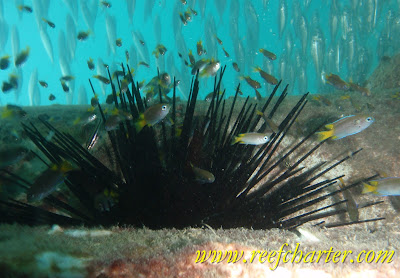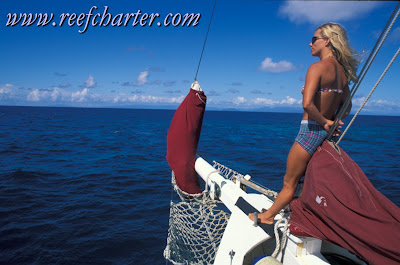The sea urchin is a common site in aquariums and reefs around the world, and the Great Barrier Reef is no different. They abound on the shallows of the reef as well as the deeper areas and walls. Sea urchins are related to sea cucumbers and starfish. Like their cousins they have tubular feet they use to crawl across the reef. They use both water and blood as circulation systems in their bodies and eat mostly algae as part of their diet. When food conditions abound they can reproduce very quickly and therefore reach large numbers in a very short period of time. Likewise when the food sources dwindle they die of in masses just as quickly.
The spines are method of protection against predators but also offers a home to juveniles of smaller fish, offering them protection also. These spines are not dangerous to humans but as always it is best not not play with the wildlife.
Category: Great Barrier Reef
We Want to Show You the Best Place to Work
With the biggest natural wonder in the world as our office and playground we lead a privileged existence. We get to experience the magnificent beauty of the Great Barrier Reef and marine life from the smallest nudibranch or shrimp to the humpback whales as they make their way north for their winter vacation. We get to scuba dive in warm water alll year round. So It can’t get much better right?
Well it can… One of the best parts of our jobs is introducing people to the wonderful ocean and the wonderous life that lives in it. Meeting people from all around the world, from the person experiencing scuba diving for the first time to the most experienced divers, sharing this natural beauty is truly a rewarding experience.
When we receive reviews and comments like this one as we often do, months after our guests have returned home it really makes our jobs even better. “The group was so happy and I spoke with tour leader and she said that literally this journey change their life!” They are planning on coming back next year as well, so the pressure is on for us to make the trip better… Thanks guys for the feedback and glad we were able to show you mother nature at it’s best.
It’s That Time of Year Again…
It’s that time of year again and bookings are coming in fast for the upcoming whale, and scuba diving season. If you are thinking of heading to Australia this year, it is best to start finalizing your plans now to visit the Great Barrier Reef. Many of our trips are already full or nearly full for the upcoming busy. We have laready had to turn down many people who delayed booking their trip.
As we only take 10 passengers to the reef at a time for that unique experience we fill up quickly. So make sure you get a chance to experience the reef and meet the beautiful fish without the crowds. Book your dive trip quickly to avoid disappointment and have a great time with us.
How Does a Coral Reef Form?
We even have a picture with labels today, don’t get used to it. This is courtesy of Fiona please see the credits below.
A coral reef is an accumulation of the limestone skeletons of dead reef organisms and the algae that glues them together.
The coral reef builds upwards, growing towards the light much like trees in a rainforest, competing for space and light. Once the coral reef reaches sea level it cannot survive the harsh surface conditions so begins to grow outwards. Creating spectacular formations of coral that spawn further growth and spreading of the reef ecosystem.
Through time, animals grow and the sand, rubble and debris of life is broken down by waves and eroding animals, such as worms and sponges. A complex reef ecosystem is built over time. Today’s underwater gullies and caves were formed because of that erosion. These are the same formations scuba divers enjoy exploring today because they are shelters for an abundance of marine life.
Coral reefs tend to grow where there is a lot of water movement, bringing nutrients, oxygen and new species. Most reef-building corals cannot grow in waters shallow enough to expose them at high tide or deeper than 50 metres, making them highly sensitive to changing sea levels.
The Reef is continually evolving and changing as climate and sea levels change. Healthy, diverse reef ecosystems are more resilient, that is, they are able to adapt to change. The Great Barrier Reef Marine Park Authority is concentrating on maximising reef resilience through research and management.
Thanks to Fiona Merida for this great information. Fiona currently runs the Eye on the Reef Program for the Great Barrier Marine Park Authority. A very successful program that brings together and unites the Great Barrier Reef Marine Park Authority, the Great Barrier Reef tourism industry and the reef research community for the greater good of protecting the reef and educating the community.



